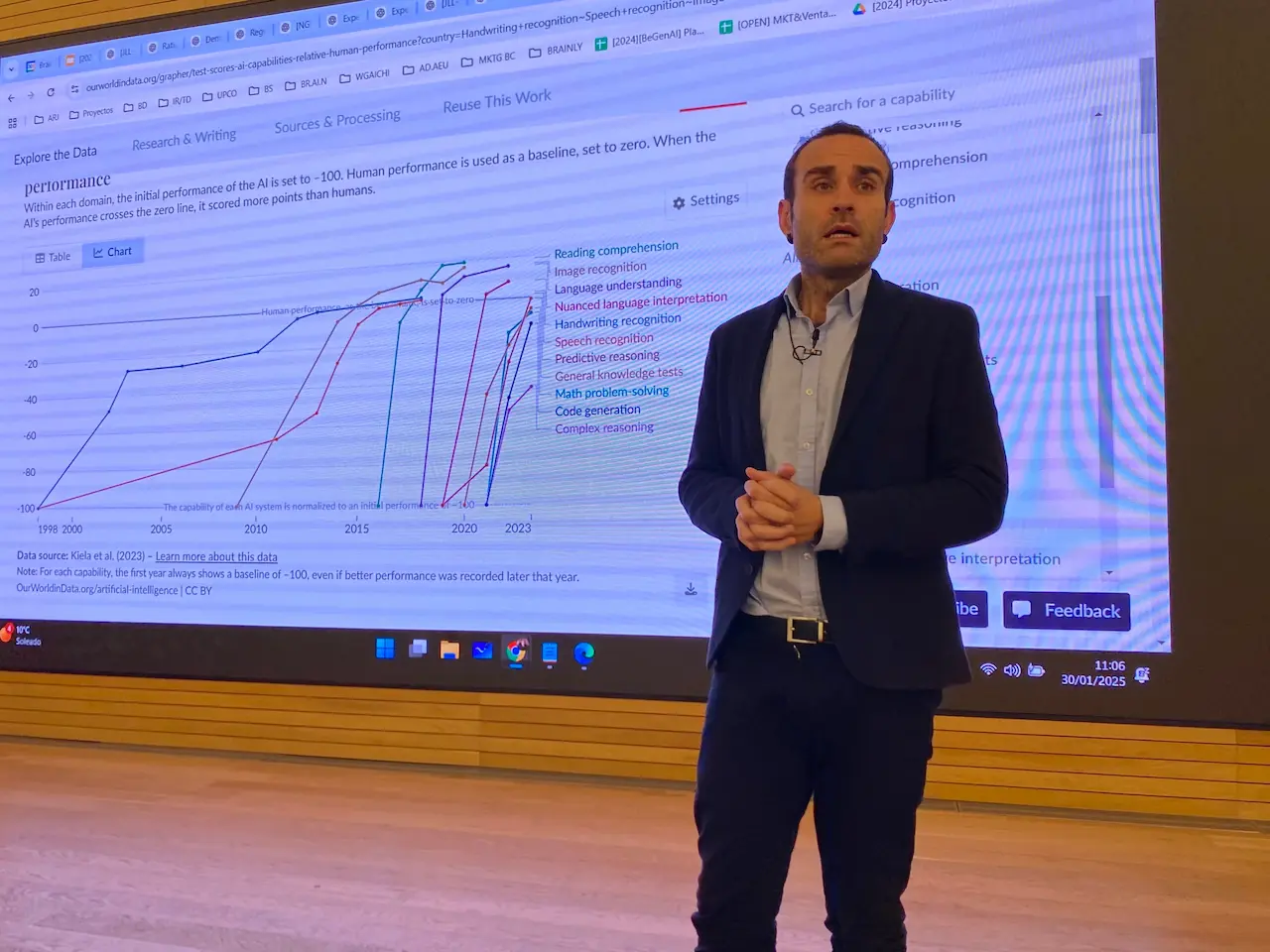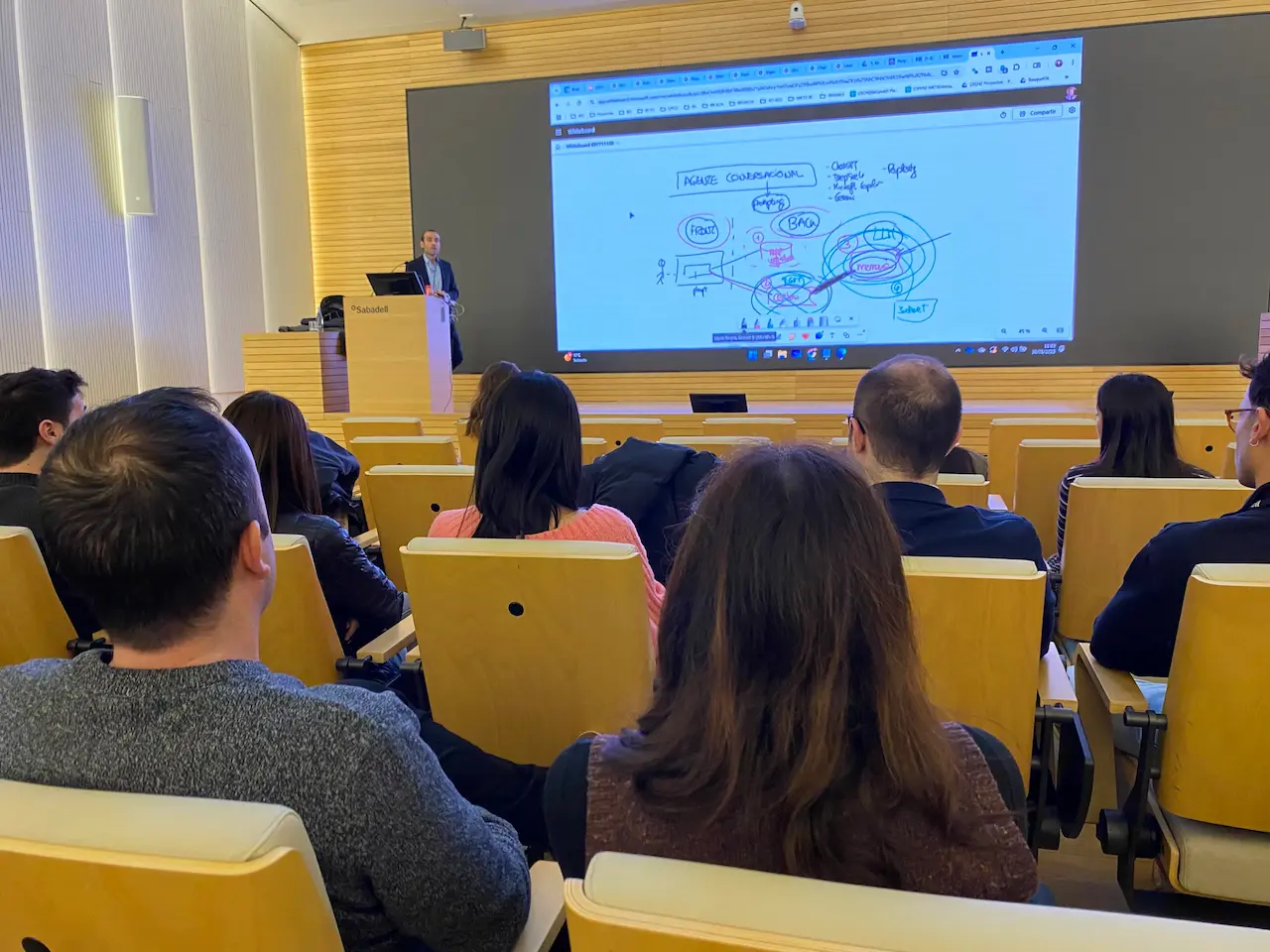A new edition of the DisruptIA cycle began on 30 January in the auditorium of the corporate building in Sant Cugat, which Banco Sabadell uses to make the Artificial Intelligence revolution available to all its employees. These sessions are recorded and released on video to be made available to anyone who might be interested in learning more about the implications and applications of artificial intelligence, which no one now doubts will profoundly change the day-to-day lives of companies and individuals alike.
Álex Bayón, CEO of the company Brain & Code and, until recently, Vice-Rector for International Relations and Digital Transformation at the University of Deusto, gave the first talk of this new edition. Brain And Code is a technology education company that runs personalised and open programmes on subjects as diverse as AI, web programming and development, cybersecurity and mobile apps, among others. He is also a professor of Economics and Digital Transformation in the Faculty of Engineering and the Business School at the University of Deusto (Bilbao).
AI is already more effective than humans at many taskss
During his talk, entitled “Learning to live with Artificial Intelligence”, he listed a large number of ways in which AI (which in his opinion should be defined as “Digital Intelligence”) is already having a positive and negative impact on companies. He began his presentation by describing a number of repetitive tasks in which these technologies have already demonstrated greater efficiency than people. Among others:
- Image recognition
- Computer code generation
- Legal text writing
- Creating text summaries from videos
Logically, this is already having a direct impact on an increasing number of company departments. Legal, Marketing or Human Resources to name but a few.
He gave the example of how his company already uses the courses that some of the world's leading universities offer publicly and free of charge to produce text-based teaching materials. Simply provide the AI with the video URL and it will transcribe it, summarise it, convert it into a didactic text and even automatically translate it into other languages. All without human intervention.

Risks of using technologies such as Artificial Intelligence indiscriminately
In contrast to the obvious improvement in productivity offered by tools such as ChatGPT or Gemini, he also mentioned some of the main risks of using them without also implementing the necessary control measures.
One risk is blindly trusting the results they offer us without these being supervised by a person. “We must always remember,” he said, that these systems are “co-pilots” that help us to be more agile. They are not captains who can be trusted to take control of the ship.
Using AI systems without absolute certainty that the data they are fed has been obtained legitimately is another important risk, especially for larger companies. Some large companies have already been required by the authorities to justify the origin of the data used by their AI systems.
“There is a wave coming that will transform everything,” he said, “but it is not a labour apocalypse as some media have been saying for some time. Of course, we must adapt to the new environment, but human intervention, at least for the time being, is still essential”.

The importance of knowing how to develop our personalised AI systems
The first thing we must all do to get the most out of AI is to identify which of the many existing systems fits our particular needs best. There are as good as each other. We have to look for the one that can give us the best service. Once identified, it will need to be “trained” for a while so that it gets to know us and our needs. He drew a parallel, saying that each of our personalised AI tools would be something like a small child that we have to educate for a while until it becomes an adult.
Alex Rayón, CEO of Brain & Code says “Studies indicate that, in a short period of time, most of us workers will have already trained 24 personalised AI systems that will help us in our day-to-day lives”
Studies indicate that soon a large proportion of workers will have “trained”, on average, some 24 “personalised AI agents” that will be able to interact with each other and to which, already today, we can give verbal orders that they understand and execute perfectly.
During his talk, available in full in the video linked at the end of this text, he also provided multiple practical examples of artificial intelligence applications and some free and little-known tools that can already be used by both companies and individuals.
To watch the full talk on Artificial Intelligence, click on this link.